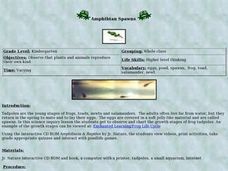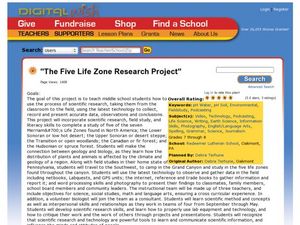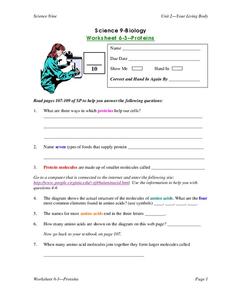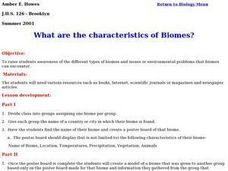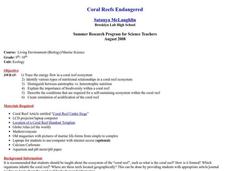Curated OER
Amphibian Spawns
Students observe tadpoles as they gradually change into adults. For this amphibian biology lesson, students watch tadpoles in a tank in the classroom, keep a daily record of what they observe, and chart the growth development of the...
Curated OER
Genome: A Tour and Genetic Disorder Brochure
Students use the Internet to gather information about genetics, then research a genetic disorder. For this biology lesson, students listen to an interview with a geneticist, watch an animation of "chromosome coiling", then research and...
Curated OER
The Five Life Zone Research Project
Students study five of the seven life zones in North America. In this journalism lesson students use the Scientific Method working in teams. They use lab equipment and technology to create a presentation on five of the seven life zones...
Curated OER
Classification of Cerealites
Students create a dichotomous key. In this categorizing lesson, students create a dichotomous key for different types of cereal. Students classify the cereal into groups such as flakes and cereal with holes. Students discuss their...
Curated OER
Branches of Science Lesson Plans
Teachers can use branches of science lesson plans to get students excited about science careers.
Curated OER
A Hard Sell on Stem Cells?
Learners examine their prior knowledge of cell regeneration and therapeutic use of stem cells. After reading an article, they discover new techniques for deriving embryonic stem cells. In groups, they research on the different types of...
Curated OER
Environmental Awareness — Think Global, Act Local
Students identify the different hazardous wastes and the dangers they post to the environment. In this physical science lesson, students brainstorm ways to dispose them properly. They create a short story, song or poem to conclude the...
Curated OER
What's Eating Titanic?
Students, in groups, research the bio deterioration of the Titanic. They write a report focusing on the rusting of the Titanic and estimate the amount of time it will take for the Titanic's bow section to completely dissolve.
Curated OER
Genetically-Modified Food
High schoolers investigate the pros and cons of genetic engineering. They watch a short Bill Moyers video, conduct Internet research, create a poster, participate in a pro/con debate, and write an essay expressing their personal feelings...
Curated OER
Genetic Research: Decisions to be Made
Students examine the genetics involved in the human genome. They brainstorm the advantages and disadvantages to this discovery. They research different experts opinion and write a case study which addresses an ethical dilemma.
Curated OER
Flower Power
Students explore the parts of flowers and how they reproduce. They dissect flowers and observe the reproductive organs. Students observe anthers and ovaries of Tiger Lilies under a microscope. They investigate how insects and other...
Curated OER
Hurricane Frequency and Intensity
Students examine hurricanes. In this web-based meteorology lesson, students study the relationship between ocean temperature and hurricane intensity. They differentiate between intensity and frequency of hurricanes.
Curated OER
How to Change the World
Biology or health classmates read a case study about a family who is dealing with fetal alcohol syndrome. The PowerPoint that is supposed to be shown is not included, but there are a plethora of web resources that can be used to help you...
Curated OER
Drosophila Melanogaster
Student manipulate flies, examine their external anatomy, begin a fly journal and make cultures of wild type flies. Young scholars cross wild type flies and mutants, both purchased from a biological supply house (Carolina Biological...
Curated OER
How Do We Generate a Large Amount of a Specific DNA Sample?
Students investigate the Polymerase Chain Reaction technique that is used to create larger amounts of a gene. They watch and discuss a PowerPoint presentation, explore a website, and write a report listing the materials needed to...
Curated OER
Mouthpart Madness
Learners explore the basic biology of a pest. They identify the four major kinds of insect mouthparts and explain how they work. Students examine the specific mouthparts and how they can limit food resources and in what environment an...
Curated OER
Gel Electrophoresis Simulation
Young scholars identify the steps in a gel electrophoresis experiment and describe the role of enzymes. They examine the relationship between fragment size and migration rate in a gel. They view DNA fragments as well.
Curated OER
Autoimmune Disease
Students conduct Internet research on an autoimmune disease, and present the information in a PowerPoint presentation.
Curated OER
Fats
In this fats worksheet, students review what fats are made up of, where fats come from, and how our body uses fats. Then students access a website to compare good fats and bad fats. This worksheet has 1 graphic organizer, 13 short answer...
Curated OER
Proteins
In this proteins worksheet, students name the types of foods that supply proteins and determine how the body uses proteins. Students understand how to acquire complete proteins. This worksheet has 1 graphic organizer, 9 short answer, and...
Curated OER
What Are the Characteristics of Biomes?
Students working in groups study different types of biomes and the issues or environmental problems that can affect them. They design a poster board that displays the characteristics of their biome. They make a model of the biome that...
Curated OER
Coral Reefs Endangered
Learners identify different types of nutritional relationships in a coral reef system and trace the energy flow. In this marine biology lesson students create a simulation of acidification of the coral reef.
Michigan State University
All About Insects
Insects are the focus of an activity that looks deep into the anatomy and metamorphosis of everyday bugs. Two worksheets reinforce knowledge obtained through a teacher-guided grand conversation and insect observation.
Curated OER
The Real Bionic Man
High schoolers examine the work that scientists have been doing to create artificial human parts. For this exploratory lesson students research the human eye and brain using the Internet.


